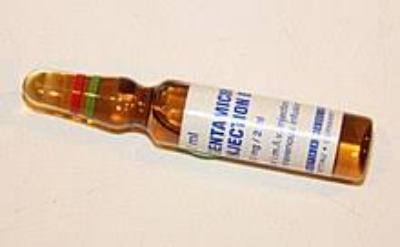


Use of ideal body weight (IBW) for determining the mg/kg/dose appears to be more accurate than on the basis of total body weight (TBW)
Infants: 2.5 mg/kg/dose IV/IM q8hr
Children and adolescents:: 2-2.5 mg/kg/dose IV/IM q8hr
2.5 mg/kg IV/IM within 60 min piror to surgical incision or without antibiotics; procedure dependent
Dose is based on actual body weight unless >20% above ideal body weight; then dosage requirement may best be estimated using a dosing weight of IBW + 0.4 (TBW- IBW)
GFR>50 mL/min/1.73m²: No dosage adjustment necessary
GFR 30-50 mL/min/1.73m²: Administer q12-18hr
GFR 10-29 mL/min/1.73m²: Administer q18-24hr
GFR <10 mL/min/1.73m² Administer q48-72hr
Intermitent hemodialysis: 2 mg/kg/dose; redose as indicated by serum concentration
Peritoneal dialysis: 2 mg/kg/dose; redose as indicated by serum concentration
Continuous renal replacement therapy: 2-2.5 mg/kg/dose q12-24hr; monitor serum concentration
Monitor peak (4-12 mg/L) and trough (1-2 mg/L)
Monitor nephrotoxicity, neurotoxicity, and ototoxicity; assess at beginning of therapy and throughout
Individualization critical due to low therapeutic index
Use ideal body weight for mg/kg/dose, except in neonates (in whom actual body weight should be used)
Neurotoxicity (vertigo, ataxia)
Gait instability
Ototoxicity (auditory, vestibular)
Nephrotoxicity (decreased CrCl)
Nephrotoxicity if trough >2 mg/L
Edema
Rash
Reddening of skin
Itching
Drowsiness
Headache
Pseudomotor cerebri
Photosensitivity
Allergic reaction
Erythema
Anorexia
Nausea/vomiting
Weight loss
Increased salivation
Enterocolitis
Granulocytopenia
Agranulocytosis
Thrombocytopenia
Elevated LFTs
Burning
Stinging
Tremors
Muscle cramps
Weakness
Dyspnea
Prior aminoglycoside toxicity or hypersensitivity
Patients treated withaminoglycosides should be under close clinical observation; high risk of toxicity associated with their use
Risk of ototoxicity; tinnitus or vertigo may be indications of vestibular injury and impending bilateral irreversible damage; discontinue therapy if signs of ototoxicity occur
Risk of nephrotoxicity; other factors that increase patient risk of ototoxicity include advanced age and dehydration
Narrow therapeutic index (not intended for long-term therapy)
Caution in renal failure (not on dialysis), myasthenia gravis, hypocalcemia, and conditions that depress neuromuscular transmission
Adjust dose in renal impairment
Endocarditis prophylaxis (GI, GU procedure): AHA Guidelines recommend only for high-risk patients
Diuretics may enhance aminoglycoside toxicity by altering antibiotic concentration in serum and tissue; certain diuretics by themselves may cause ototoxicity; avoid potent diuretics, including ethacrynic acid or furosemide
Use caution in patients with electrolyte abnormalitie including hypocalcemia, hypomagnesemia, or hypokelemia
Use caution in patients with neuromuscular disorders, including myasthenia gravis
Use caution in patients with hearing and renal impairment
Pregnancy category: D
Lactation: Enters breast milk; use with caution (AAP Committee states "compatible with nursing")
A: Generally acceptable. Controlled studies in pregnant women show no evidence of fetal risk.
B: May be acceptable. Either animal studies show no risk but human studies not available or animal studies showed minor risks and human studies done and showed no risk.C: Use with caution if benefits outweigh risks. Animal studies show risk and human studies not available or neither animal nor human studies done.
D: Use in LIFE-THREATENING emergencies when no safer drug available. Positive evidence of human fetal risk.
X: Do not use in pregnancy. Risks involved outweigh potential benefits. Safer alternatives exist.